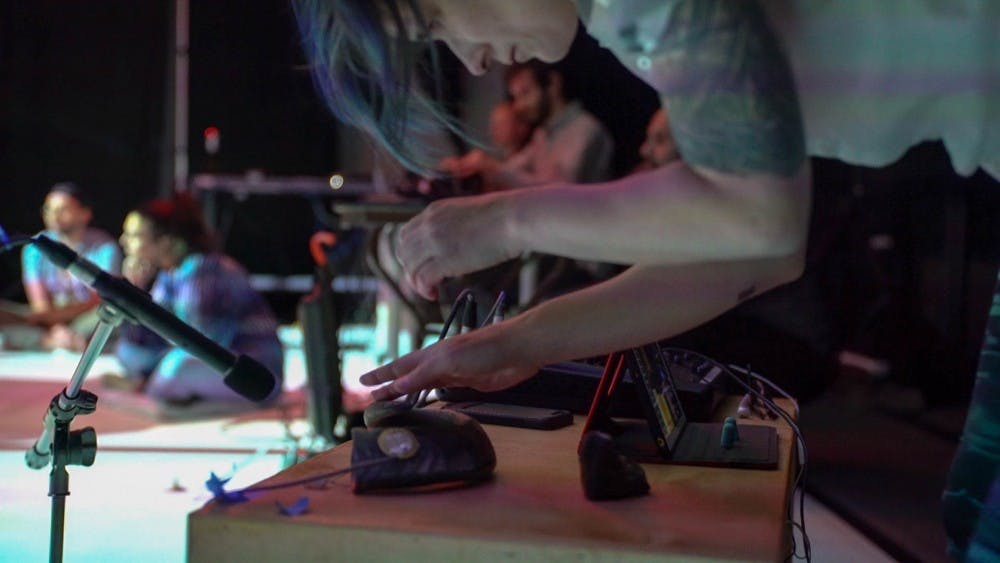The beauty of music is found not only in the final product but also in the process that goes into creating and performing.
The Laboratory for Laptop and Electronic Audio Performance Practice is a researcher-led project that unites multiple disciplines to explore elements of this process through video, performance and technology.
LLEAPP was introduced at ASU by Lauren Hayes, an assistant professor in the School of Arts, Media and Engineering, as a way to foster collaborative, practice-based dialogue between faculty and researchers at ASU and participants from elsewhere in the U.S. as well as the U.K. and Mexico.
LLEAPP presents its findings at public events, such as a concert on April 9 involving short solo and group compositions and improvisations and a presentation on April 12 demonstrating the findings of a workshop exploring interdisciplinary improvisation.
The fruits of this research can take many forms, such as immersive audio-visual performances and compositions made up of music, data visualization and art.
Hayes established LLEAPP while in graduate school at the University of Edinburgh in 2009 alongside Jules Rawlinson and others.
"LLEAPP was originally conceived as the Laboratory for Laptop and Electronic Audio Performance Practice but has not been restricted by any of these descriptors," Hayes wrote in an email. "The project is a platform for participants to engage in self-directed collaborative creative practice research. There have been numerous textual research outputs in addition to media and performances."
Hayes is also the research lead of Practice and Research in Enactive Sonic Art, which focuses on live electronic music performance, extended interdisciplinary applications of enactive and embodied music cognition, technology, design and the connections between these themes.
For the April events, Hayes said she wanted to bring together an exciting collection of interdisciplinary researchers and practitioners based around the theme of improvisation.
Hayes worked with Lyn Goeringer, a professor at Michigan State University, to curate a selection of early-career researchers and artists. The diverse group of participants study and work with sound, music, light, projection, movement, dance and technology.
Rawlinson, who is program director for design and digital media at the University of Edinburgh, is known best for his collaboration with artist and writer Matthew Collings on "A Requiem for Edward Snowden." Rawlinson said the process of creating art through this interdisciplinary practice is repetitive and reflective.
He said the projects start through a collaborative process where artists can explore and consider the range of creative possibilities, skills and experiences in the group. He said much of this year's events were quite low-tech or even no-tech, relying on creative responses to limitations.
"LLEAPP allows us to explore and blur the boundaries of collaborative practice," Rawlinson said. "All of this year’s participants have been pushed quite far outside their own comfort zone as a way to gain new insights into their own relationship with technology and the body."
Rawlinson said in the United Kingdom, many former LLEAPP participants are working across a wide range of academic institutions and that the LLEAPP experience is passed down to students through a network of teaching and practice.
"We hope that we’ll see the same in the U.S. now that LLEAPP has jumped the Atlantic," Rawlinson said.
Noah Rudko, a civil engineering junior, said music is often viewed as a pure art form, but the cross-disciplinary area such as LLEAPP is a brilliant example of how engineering and science can be seen in art.
"What sets it apart from traditional engineering is that many people would not consider applying engineering principles outside of engineering," Rudko said. "It is important to think of new and innovative ways to apply what we learn."
He said one modern example of this can be seen through the construction of amusement park rides, where art and engineering are constantly colliding.
Rudko said as an engineer, it is important to push creative boundaries and that LLEAPP is a leading example of several disciplines coming together to create something beautiful.
"Some people view engineering and art as being mutually exclusive, but this disciplinary area is a great example of how the two are incredibly alike," Rudko said. "Being able to create beautiful performances using engineering principles should be encouraged in both art and engineering specialties."
Correction: A previous version of this article incorrectly listed Marcin Pietruszewski as one of the founders of LLEAPP and Lyn Goeringer as the composer of "A Requiem for Edward Snowden" instead of Matthew Collings. The article has been updated to correct these mistakes.
Reach the reporter at pthaung@asu.edu or follow @seaboiii on Twitter.
Like The State Press on Facebook and follow @statepress on Twitter.




